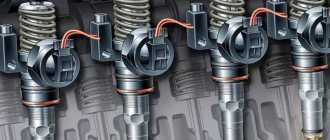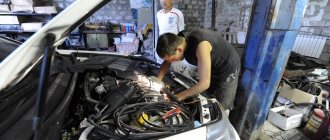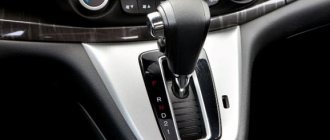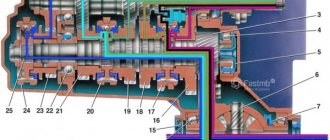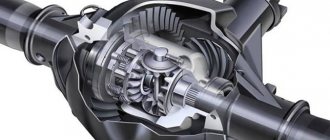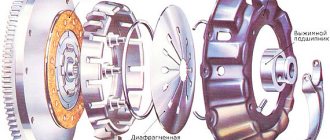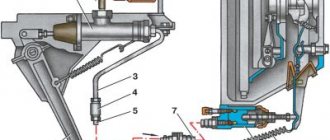A driveshaft is a device for transmitting torque from a gearbox or transfer case to the rear wheels.
Widely used on rear-wheel drive and all-wheel drive vehicles from the beginning of the twentieth century to the present. The cardan transmission device was first described in the 16th century, but the creation of the device in practice occurred much later.
Cardan shaft device
The cardan transmission diagram includes the following elements:
- One or more sections of thin-walled hollow pipe;
- Splined sliding connection;
- Forks;
- Crosspiece;
- Suspension bearing;
- Fastening elements;
- Rear movable flange.
The unit itself can be single-shaft or double-shaft. In the second case, the mechanism includes an intermediate cardan shaft, to the rear section of which a shank with external splines is welded, and a sliding sleeve is fixed to the front section through a hinge. Single-shaft systems do not have an intermediate section.
At the front of the car, the unit is fixed in the gearbox using a movable spline connection (a movable coupling of the front part of the propeller shaft). To do this, there is a hole with internal slots at the end of the mechanism. The driveshaft design implies the possibility of longitudinal displacement of the splines when the vehicle is moving.
Next, the driveshaft suspension bearing is installed, which is attached to the body through a bracket. This serves as an additional fastening of the unit, preventing its excessive displacement when driving.
Next comes the driveshaft fork, which is located between the front and middle parts. A cross is installed here, on which there are needle bearings. The presence of forks and a cross makes it possible to transmit torque at different bending angles of the “cardan”.
At the rear, the transmission is attached to the rear axle gearbox via a flange. In this case, the shank, equipped with external splines, fits into the flange of the main gear drive.
[custom_ads_shortcode1]
Design and principle of operation
A cardan shaft consists of several elements: a shaft, two crosspieces, a sliding fork, seals, fastening parts and a number of other elements, depending on the design. The driveshaft can consist of one, two, three or more sections. The length, thickness and weight of the shaft depend on the dimensions of the vehicle.
Cardan cross.
A single-section propeller shaft consists of a central part and tips with crosses attached to it. The central part is made of steel pipe. The use of a pipe is due to the need to reduce the weight of the shaft and save metal. Only very short shafts are made solid.
Single-section shafts are mainly used in sports cars. For example, a single-section cardan is used in the design of the Nissan GT-R.
The driveshaft is one of the most repairable parts. It is easy to remove from the car, and the repair consists of replacing the crosspieces and the suspension bearing
Cardan joint.
The operation of the cardan transmission is ensured by hinge mechanisms based on crosses. Crosses allow two mating shafts to rotate at varying angles to each other. The highest efficiency is achieved when the rotation angle is between 0° and 20°. When this figure is exceeded, the crosspiece is subjected to heavy load. In addition, the shaft loses balance and begins to vibrate.
Another important element is the sliding spline joint of the cardan. Its use is due to the fact that the car’s suspension, especially when overcoming obstacles, significantly stretches in height. The gearbox or transfer case, to which one end of the shaft is attached, is rigidly fixed inside the body, and the axle gearbox (the second point of attachment of the cardan) is connected to the suspension. As a result, when moving over an obstacle, the distance between the gearbox and the axle gearbox increases. In this case, the driveshaft must “stretch”, and the sliding spline joint helps it do this.
Another important component of the driveline is the suspension bearing. It provides additional support for the composite shaft, holding it in place and not preventing it from rotating. The bearing bracket is attached to the body. The number of bearings depends on the number of sections that make up the shaft.
Operating principle of HF
The principle of operation of the cardan transmission is the ability to transport torque when the position of the “cardan” in space changes. This principle is implemented through two mechanisms:
- Sliding fork of the cardan shaft;
- Cross joint.
A sliding fork is necessary to slightly increase the length of the mechanism when driving on uneven roads. Due to the long spline connection, the supply of torque does not stop when the suspension, together with the rear axle, moves up or down. The hinge, in turn, ensures rotation of the wheels when the bending angle of the CV changes. It is believed that the mechanism is capable of working productively at angles of no more than 20°. Then its active wear begins.
[custom_ads_shortcode2]
From a technical point of view
Despite the fact that we previously explained that a cardan shaft is not a cardan coupling (in everyday life it is absolutely ignorant to say so, and it will only confuse the interlocutor), from a technical point of view this is exactly the case
If we take into account the correct definition of a cardan according to the basic principle of its operation and the main element, without which a shaft without a coupling would definitely not be called a cardan, but simply a drive
Cardan joint, crosspiece - all these are synonyms for cardan coupling
photo: cumminsforum.com
This joint is the main connecting element that unites the cardan shafts, that is, the rear and front driveshafts (intermediate and main shaft)
On long-wheelbase vehicles or when it is necessary to deviate part of the cardan from a given plane, this is very important, since only the cardan cross (coupling), being the main element of the movable cardan joint, allows rotation to be transmitted between two misaligned shafts
Types of cardan drives
In the modern automotive industry, the following types of cardan transmissions can be used:
- Equipped with a unequal velocity joint (classic car driveline);
- Equipped with CV joints (constant velocity joints);
- Equipped with semi-cardan elastic joints;
- Equipped with rigid semi-cardan joints.
The system with the NUS hinge is considered classic. There are forks, crosspieces, and needle bearings. Suitable for most rear wheel drive vehicles.
Modern SUVs often use a system equipped with CV joints. Such devices provide more comfortable driving conditions, almost completely eliminating vibrations.
Elastic hinges are a rubber coupling capable of transmitting torque at bends of no more than 8°. The rubber is quite soft, so a shaft with a similar structure ensures a smooth start of movement and the absence of sudden dynamic loads. In addition, flexible connections require no maintenance. The rigid semi-cardan joint has a complex technical device and transmits torque due to gaps in the spline connection. Due to the complexity of manufacturing, technical shortcomings and rapid wear, it is not used in the automotive industry.
[custom_ads_shortcode3]
Hinge: the main secret of the cardan
It is quite obvious that the cardan transmission, the purpose and design of which we are considering today, is an extremely important unit.
Therefore, let's not waste time on unnecessary talk and get to the heart of the matter. The cardan transmission of a car, no matter what model it is in, has a number of standard elements, namely:
- hinges;
- drive, driven and intermediate shafts;
- supports;
- connecting elements and couplings.
The differences between these mechanisms are usually determined by the type of universal joint. The following execution options exist:
- with a hinge of unequal angular velocities;
- with a constant velocity joint;
- with a semi-cardan elastic joint.
When motorists say the word “cardan”, they usually mean the first option. A mechanism with an unequal velocity joint is most often found in cars with rear-wheel drive or all-wheel drive.
The operation of this type of cardan transmission has one feature, which is also its disadvantage. The fact is that, due to the specific design of the hinge, it is impossible to smoothly transmit torque, but this can only be done cyclically - in one revolution the driven shaft is twice behind and twice ahead of the drive.
This nuance is compensated by introducing another similar hinge. The device of this type of cardan transmission is simple, like everything ingenious - the shafts are connected by two forks located at an angle of 90 degrees and fastened with a cross.
More advanced are the options with constant velocity joints, which, by the way, are usually called CV joints - you've probably heard this name.
The cardan transmission, the purpose and design of which we are considering in this case, has its own nuances. Although its design is more complex, this is more than compensated for by a number of advantages. So, for example, the shafts of this type of cardan always rotate evenly, and they can be at an angle of up to 35 degrees. The disadvantages of the mechanism include, perhaps, a rather complex layout of the unit.
The CV joint itself must always be sealed, since there is a special composition of lubricant inside. Depressurization leads to leakage of this lubricant, and in this case the hinge quickly deteriorates and breaks. However, mechanisms with constant velocity joints, with proper care and control, are more durable than their counterparts. You can find CV joints on front-wheel drive and all-wheel drive vehicles.
The design and operation of a cardan transmission with a semi-cardan elastic joint also has its own characteristics, which, by the way, do not make it possible to use it in the designs of modern cars.
The transmission of rotation between two shafts in this case occurs due to the deformation of an elastic element, for example, a specially designed coupling. It is believed that this option is extremely unreliable, which is why it is not currently used in the automotive industry.
Well, friends, the purpose and design of the cardan transmission, as well as the varieties of which we have revealed in this article, turned out to be a fairly simple mechanism that brings a lot of benefits.
In the next publication we will talk about an equally useful thing. Which one? Subscribe to the newsletter and be sure to find out!
Frequent malfunctions and their elimination
All malfunctions can be divided according to emerging signs of failure:
- Vibration when moving - the bearings of the cross or the sliding sleeve are worn out, the balancing of the shaft is disrupted;
- Knocks when starting - the sliding joint splines are worn out, the fastening bolts are loose;
- Oil leakage from the bearings means wear of the seals.
To eliminate the problems described above, the “cardans” are dismantled and defective, and faulty parts are replaced. If there is an imbalance, the shaft must be balanced under dynamic conditions. Be sure to readReplacing the driveshaft cross
[custom_ads_shortcode1]
The process of removing and replacing the product
The sequence of actions when replacing the front axle drive on UAZ Patriot vehicles is described below.
- Place the car on an overpass or lift, first placing wheel chocks under the wheels.
- Mark the position of the driveshaft and flanges of the transfer gearbox and front axle with chalk or a chisel. The tags will allow you to continue operating the car with the old drive.
- Clean the bolts securing the drive to the flanges. To make product removal easier, apply WD40 to the connections.
- Unscrew the mounting points. If you cannot remove the bolts, cut the metal elements with a circular saw. To fasten the cardan at the front and rear, 4 bolts with nuts are used; the elements are unscrewed using 2 wrenches of 14 and 17 mm.
- Remove the worn drive and install a new part in its original place. During installation, it is recommended to use new bolts with a special sealant applied to the threads, which prevents the elements from being loosened during operation.
- A new drive requires balancing, which is performed at a service station. It is prohibited to operate a vehicle with parts that have not been balanced, because vibration increases and there is a risk of destruction of transmission elements.
Prospects for the development of a cardan transmission system
The classic ShNUS has some technological disadvantages. The rotation speed of its shafts changes during movement. In this case, the driven shaft can accelerate and decelerate at a stable speed of the drive shaft. This leads to accelerated wear of the mechanism and also creates excess load on the rear axle. Also, the operation of the hinge is accompanied by vibration.
The purpose of the cardan drive can be performed by a shaft equipped with CV joints (front and rear). Similar systems are already used on some SUVs today. Also, the cardan transmission of the VAZ-2107 and other “classics” can be equipped with a CV joint. Repair kits are available for sale.
The use of a constant velocity joint eliminates the disadvantages inherent in the classic cross. The shaft rotation speed is leveled out, vibration disappears, the HF does not require balancing after repair, and the torque transmission angle increases to 17°.
[custom_ads_shortcode2]
Cardan: why is it needed?
So, what problems might arise if we wanted to transfer torque from the engine to the wheels? At first glance, the task is quite simple, but let's take a closer look at it. The fact is that, unlike the engine and gearbox, the wheels together with the suspension have a certain travel, which means that it is impossible to simply tightly connect these units. Engineers solved this problem using a cardan drive.
It allows you to transmit rotation from unit to unit, which are located at different angles, and also to balance all their mutual vibrations without compromising the transmitted power. This is the purpose of the cardan transmission.
The key element of the mechanism is the so-called cardan joint, which is the very clever engineering solution that allows you and me to enjoy car rides.
It must be said that cardans are used in various components of the machine. Basically, of course, they can be found in the transmission, but besides this, this type of transmission is relevant for the steering system.
Where else are cardan-type shafts used?
What is a driveshaft used for, other than connecting the gearbox to the axle and wheels? In reality, the scope of application of NUS hinges is quite large. They are used to create adjustable steering columns, where it is necessary to transmit torque from the steering wheel to the wheels. Cross joints are also used in tool sets. They allow you to work on bolts that are not in a straight line with the wrench extension.
Today, universal joints, despite their widespread use in many areas of industry, are considered obsolete. CV joints are becoming more and more developed, and crosspieces and forks are slowly becoming a thing of the past.
The cardan transmission is used to transmit torque from the gearbox or from the transfer case to the drive axle of the vehicle at changing angles between the shafts of these units. This transmission is needed because the angle of inclination of the driveshaft connecting the drive axle to the gearbox or transfer case changes while the car is moving, since the drive axle is attached to the car frame on springs and can move relative to it.
The cardan drive consists of cardan joints (universal joints) and shafts. The cardan is the main mechanism that transmits torque from one shaft to another.
The main parts of the cardan: a cross 16 and two forks 7 and 15 with eyes. The spikes 17 of the crosspiece enter into the eyes of the forks and are hingedly fixed in them using steel cups 9 with needle bearings 10, protected from the penetration of dirt and leakage of lubricant by oil seals 13. The bearings are lubricated through an oiler 8, from which oil is supplied to the bearings through channel 19, drilled in cross. To eliminate excessive lubricant pressure, a safety valve 18 is installed in the crosspiece.
Rice. Cardan structure: 1 - cardan shaft; 2 — oil seal cover; 3 - oil seal; 4 — splined shaft tip; 5 — oil seal washers; 6 — oiler of the cardan sliding fork; 7 and 15 - forks; 8 — crosspiece oiler; 9 — needle bearing cup; 10 — needle bearing; 11 — bearing support ring; 12 — bearing housing; 13 — oil seal; 14 — oil seal body; 16 — cross; 17 - spike; 18 - safety valve; 19 — channel for oil; 20 — plate for fastening the bearing cup; 21 — locking plate; 22 — clamp; 23 — rubber corrugated cover.
The cardan cross can freely rotate at a certain angle relative to the yoke of one shaft, and the yoke of the other shaft can also rotate relative to the cross. The splined connection of one of the cardan forks with the shaft forms a sliding connection, as a result of which the length of the cardan transmission can change with mutual movements of the gearbox (transfer case) and the drive axle.
To reduce friction, the spline connection is lubricated through a grease nipple 6. The spline connection is protected from dirt and lubricant leakage by an oil seal 3 with a cover 2. For the same purpose, a rubber corrugated cover 23 is used, secured to the cardan shaft and the movable cardan fork with tension clamps 22.
In a cardan transmission that includes only one cardan, the rotation speed of the driven shaft is not constant when the drive shaft rotates uniformly. This unevenness increases sharply with increasing angle between the driven and driving shafts. To avoid uneven rotation, cars use a double cardan drive, i.e.
e. a shaft with two cardans. In such a transmission, provided that the forks of both cardan shafts are installed on the shaft in the same plane, the uneven rotation created by the first cardan is leveled by the second cardan.
To ensure uniform rotation of the shafts, the sliding forks of the cardan shafts during assembly must be installed so that the arrows on the shafts and forks are in the same plane. The assembled driveshafts are bolted with fork flanges to the flanges of the gearbox, transfer case and drive axle shafts.
Cardan shafts are made tubular with tips welded on the ends, one of which has splines, and the other has a cardan fork.
A car's cardan transmission is a mechanism that transmits torque between shafts that intersect in the central part of the car's cardan transmission and are distinguished by the possibility of mutual angular movement. It is actively used in various spheres of human activity in cases where the alignment of rotating elements is very difficult to ensure. A gear coupling can also perform similar functions.
Typically, a car's driveline is used in an automobile's transmission as well as steering. The car's driveline can provide connection to the following transmission elements:
- Power unit and gearbox;
- Gearbox and transfer case;
- Gearbox and final drive;
- Main gear and transfer case;
- Drive wheels and differential.
The driveshaft in a car is designed to transmit torque from the gearbox to the drive axles in the case of an all-wheel drive or classic layout. Also used in a safety steering column to connect the steering actuator and the steering shaft.
The cardan transmission of a car has one significant drawback - non-synchronism of shaft rotations (one of the shafts has uniform rotation, the other does not). The rotations begin to increase if the angle between them increases. This eliminates the possibility of using an automobile driveline in some applications, such as the transmission of front-wheel drive vehicles (where the main problem is transferring torque to the car's turning wheels).
By and large, this disadvantage can be compensated for by using paired hinges on one shaft, which are rotated a quarter of a turn relative to each other. However, where synchronization is necessary, as a rule, a CV joint (constant velocity joint) is used - a more complex, but more advanced design for a similar purpose.
According to their layout, the cardan transmissions of a car are divided into closed and open.
Closed version of the car's driveline
is located inside the pipe, which, in turn, can be perceived by a component of the car’s suspension. In the driveline of this type of car, only one joint is used, and the uneven rotation of the driveshaft is compensated by its elasticity. There are designs where the function of the driveshaft is performed by a torsion bar (small elastic shaft); There are no cardan joints here.
Open version of the car's driveline
does not have a pipe, and the reactive moment is perceived by reaction rods or springs. The propeller drive of a car must include at least two hinges, as well as a compensating link, since the distance between the connected units changes while driving. On cars with a long wheelbase, a car driveline is used, which consists of two shafts. Due to this, the possibility of the maximum angular velocity of the shaft coinciding with the acceptable one is eliminated. Reducing the shaft length increases its critical rotation speed, which should be at least 1.5 times higher than the maximum possible during operation. The design of a car's cardan transmission, equipped with two shafts, requires the use of an intermediate support for one of the two shafts, the bearing of which is mounted on the body or frame in an elastic ring to compensate for the axial movement of the engine (see car engine design).
[custom_ads_shortcode3]
Design and principle of operation
The HF includes several elements:
- shaft,
- two crosses,
- sliding fork, seals,
- fastening parts, in particular the suspension bearing,
- a number of other elements, which depends on the type of design.
The HF may include several sections - one, two, three or more. The dimensions and weight of the shaft depend on the dimensions of the vehicle. The device of a single-section propeller shaft includes a central part and tips with crosses attached to it.
Cardan shaft device
The functionality of the cardan transmission (GT) system is ensured by hinge mechanisms based on crosspieces. Cross
enable two mating shafts to rotate at varying angles relative to each other. The highest efficiency is achieved at a rotation angle of 0°...20°. In the case when this indicator is exceeded, the cross is subject to significant overloads. In addition, the shaft loses balance and vibration appears.
Another important element is the sliding spline connection
KP. Its use is due to the fact that the car’s suspension, especially when overcoming obstacles, significantly stretches in height. The gearbox or transfer case, to which one end of the shaft is attached, is rigidly fixed inside the body, and the axle gearbox (the second point of attachment of the gearbox) is connected to the suspension. As a result, when moving over an obstacle, the distance between the gearbox and the axle gearbox increases. In this case, the HF must “stretch”, and the sliding spline connection helps it do this.
Another important part of the gearbox is the outboard bearing.
. It provides additional support for the composite shaft, holding it in place and not preventing it from rotating. The bearing bracket is attached to the body. The number of bearings depends on the number of sections that make up the shaft.
Cardan transmission device
The cardan transmission consists of drive and driven shafts, which are connected by a flexible joint. The flexible articulated joint allows rotation to be transmitted smoothly when the angle between the two shafts changes slightly. Based on the type of articulated joint, there are two types of cardan drives:
- outdated unequal velocity joints;
- more modern constant velocity joints.
A cardan transmission based on unequal velocity joints is most often used to connect the output shaft and the drive axle in rear-wheel drive cars and trucks. In addition, such hinges are used to connect transfer cases and other auxiliary equipment. Constant velocity joints, which are more advanced in design, are used in modern front- and all-wheel drive vehicles. Through such cardan drives, the drive wheels of the vehicle are connected to the differential of the drive axle.
[custom_ads_shortcode1]
Useful tips
Remember that you should never ignore any signs of a cardan malfunction. If you do not heed this advice, you may experience the following consequences:
- If the cardan breaks, the vehicle body itself is damaged. Additionally, the cardan can damage the pipeline that runs along the bottom of the car.
- If constant vibrations are observed, this will negatively affect the rigidity of the suspension and body mounts. All threaded connections and fastenings of interior panels will also begin to loosen. The car will literally begin to fall apart while driving.
- All parts directly connected to the driveshaft will wear out faster and more intensely. This will significantly shorten their service life and require early replacement and expensive repairs.
It is unlikely that any car owner will consciously want to face such troubles.
But in many ways they can be avoided if you follow a few simple rules. All these recommendations are aimed at increasing the service life of the driveshaft.
If you are interested in preserving the HF resource, then you need to:
- try to minimize vehicle operation in rough terrain;
- do not accelerate sharply;
- move away smoothly;
- do not skid the car for a long time;
- do not skimp on quality spare parts;
- carry out diagnostic measures;
- If complex faults occur, contact qualified technicians.
The driveshaft is in many ways an important element of a vehicle, which, although considered an intermediate link, plays a key role in the operation of rear-wheel drive and all-wheel drive vehicles.
The unit does not have an extremely complex structure, and its operating principle is clear to many. This allows you to independently solve problems that arise, detect faults in a timely manner and maintain the HF in working order for a long period of time, simply by following a few simple rules.
OPERATING FEATURES OF THE CARDAN TRANSMISSION
A feature of this hinge is uneven rotation. When the angle of position of the drive shaft relative to the driven one changes, the latter accelerates or slows down at certain points, that is, the angular velocity increases or decreases. Moreover, as the angle increases, the speed of advance or lag of the driven shaft from the drive shaft increases, so this transmission of rotation is cyclic in nature.
A significant angle (more than 20 degrees) between the shafts increases the load on the hinge components, which can lead to failure.
Let's look at the principle of operation of a cardan joint using an example when the drive shaft is positioned strictly horizontally, and the driven shaft is positioned at an angle downwards (standard position of the cardan joint). The initial position of the inner hinge fork is also horizontal. When transmitting rotation due to the angled position, the downward portion of the fork accelerates relative to the drive shaft. Maximum advance is achieved at the bottom point. At the same time, part of the driven shaft fork, which began to move upward during rotation, slows down and lags behind the driving one in rotation speed. The maximum lag is at the highest point.
Due to these features of the operation of the joint of unequal angular velocities, rotation is transmitted unevenly. To reduce the unevenness of rotation speeds and loads, the design of the cardan transmission uses two hinges - at the ends of the hollow shaft. Moreover, for maximum smoothing, the internal forks are located in the same plane.
Due to the use of two hinges, the position angles of the shafts and, accordingly, the unevenness of rotation speeds are reduced.
Due to the uneven rotation between the shafts, the cardan transmission is not used in the transmission design of front-wheel drive vehicles. On such models, the unequal velocity joint is replaced by a constant velocity joint, in which transmission is carried out evenly regardless of the angle between the shafts.
[custom_ads_shortcode2]
general description
The program received its name from Gerolamo Cardano, who described it in the 16th century. (but did not invent).
The cardan transmission has a significant drawback - non-synchronism of shaft rotation (if one shaft rotates evenly, the other does not), which increases with increasing angle between the shafts. This eliminates the possibility of using a cardan drive in many applications, for example, in the transmission of front-wheel drive cars (where the main problem is transmitting torque to the steering wheels). In part, this disadvantage can be compensated by the use of paired hinges on one shaft, in which the intermediate shaft forks are in the same plane. However, where synchronization is required, as a rule, it is not a cardan drive that is used, but a constant velocity joint (CV joint) - a more advanced, but also more complex design for the same purpose.
ADVANTAGES
The advantages of cardan transmission include:
- Work with significant torques.
- Possibility of connecting transmission units installed at large distances from each other.
- Implementation of all-wheel drive on a car.
- Simplicity of design.
- Resistance to loads.
But at the same time, the cardan increases the metal consumption of the transmission and requires significant space for installation, which affects the usable volume of the cabin.
Cardans with unequal velocity joints do not require maintenance and at the same time have a significant service life. Despite the use of bearings in the design, there is no need to lubricate them during operation, since the joint itself is maintenance-free, and the lubricant supplied by the manufacturer is enough for the entire service life.
The cardan is a non-repairable unit. When bent, the cardan requires complete replacement. This is due to the fact that the unit is balanced during manufacturing. Bends lead to imbalance, which increases vibrations and loads in the gearbox and final drive and accelerates wear of the joints.
The hinges are also not repairable, therefore, if increased vibration appears from the cardan side, or third-party sounds (crunches, clicks), the components of the hinge are replaced. Usually the crosspiece and its bearings are subject to replacement, but if the lugs are very worn out, the assembly assembly is replaced.
[custom_ads_shortcode3]
A few words about repairing the cardan mechanism
The repair procedure for the cardan mechanism consists of the following steps:
- Firstly, we determine the exact cause of the breakdown through a detailed inspection of the unit in an inspection hole or on a lift;
- After this, already knowing what needs to be changed, you need to prepare the tools and parts for replacement. The most commonly performed procedures are:
- replacement of consumables.
When selecting new parts, it is important to consider the overall dimensions of your mechanism, especially the length of the torque forks, since it changes the most when the shafts operate. You can find out the dimensions from special technical literature.
For example, let's pay attention to the dimensions of the “cardan” of some UAZ models:
Having prepared the necessary tools, all that remains is to fix the breakdown. Fortunately for many motorists, the design of the driveshaft is quite primitive, as a result of which assembly and disassembly of this mechanism is very simple.
In general, there are no particular difficulties in understanding the general essence of cardan shafts. Despite the simplicity of the device and acceptable reliability, such mechanisms have large dimensions and considerable weight, which affects their limited serial use. In any case, “cardans” were used previously and are still in use, so it would be useful for every motorist to know about their structure and operating principles. We hope the material presented above helped you figure this out. Good luck on the roads and in car maintenance!
Types of driveshafts
The main role in the cardan drive is played by the cardan joint, depending on the design of which the following types of cardan drives are distinguished:
- transmission with constant velocity joint;
- transmission with unequal velocity joint;
- transmission with a semi-universal elastic joint;
- transmission with a semi-cardan rigid joint.
By the number of shafts, cardan transmissions can be: single-shaft, double-shaft and multi-shaft, and by the number of hinges - single-joint, double-joint and multi-joint.
[custom_ads_shortcode1]
What function does it perform?
The main task of this mechanism is to transmit rotational movements to axes located in different planes. The gearbox is located higher than the rear wheel axle of the car. If you install a straight beam, due to the displacement of the axes, it will either break itself or break the frame and bridge assemblies.
Another reason why this device is needed is the mobility of the rear axle of the machine. It is mounted on shock absorbers, which move up and down while driving. In this case, the distance between the gearbox and the rear gearbox is constantly changing. The sliding fork compensates for such differences without losing torque.
Consequences of improper operation of the cardan
As we have already noted, problems with the cardan are primarily recognized by increasing noise and significant vibrations coming to the body while the vehicle is moving.
If the driver has iron nerves and incredible calm, then ignoring vibrations and loud noise due to a worn driveshaft will certainly lead to unpleasant consequences. The worst thing that can happen is the shaft breaks while driving. This is especially dangerous and always leads to accidents when the shaft breaks in the front of the car.
If signs of a cardan problem appear while driving, the driver needs to reduce speed and stop the vehicle as soon as possible. Having marked the place where the car is stopped, it is necessary to carry out a visual diagnosis of the car. Here's what you need to pay attention to:
- For all bolted connections;
- On the condition of the outboard bearing, especially on its rubber damper;
- On the condition of the flanges;
- On the crosspieces;
- On the bearing caps.
It is not recommended to disassemble the shaft yourself, either on the road (to replace a broken part) or in a garage, if the car owner does not have the appropriate skills. Repair of the cardan must always be accompanied by its balancing, which is impossible to do in road repair conditions.
For these reasons, the condition of this part of the transmission must be monitored. Scheduled technical inspection and, if necessary, repairs are the key to proper and safe operation of any vehicle system and its components, including the driveshaft.
Service
The crosspieces in some shafts provide for changing the lubricant through grease nipples. For injection, a syringe is used that injects lubricant under pressure.
The lubricant itself must be specifically designed for crosspieces; universal compounds do not work well here. The same applies to lubrication of spline joints.
It is better to carry out maintenance operations after each exposure to difficult road conditions when liquid dirt and water come into contact with the hinge. The joint must be injected until all four cups of clean injected lubricant begin to emerge from under the seals.


